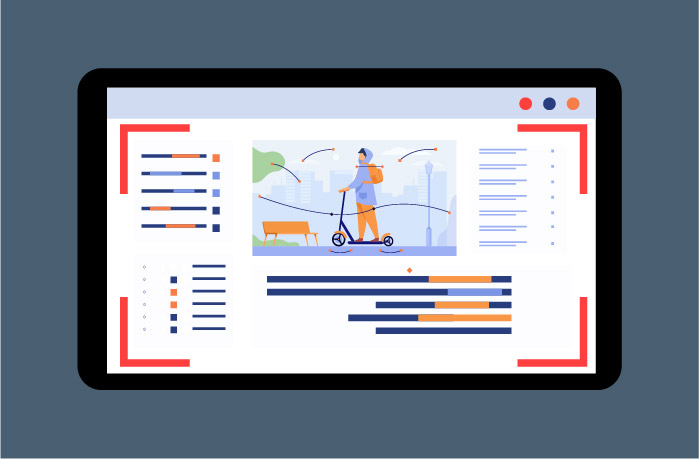Do you want to teach your students effectively? Or want to give them a hands-on software experience through video? Then, this read is for you!
We will be covering all the vital information about screencasting: use, benefits, tools, and everything that you need to know.
So, without any further ado! Let’s begin!
What is Screencasting?
Screencasting is a digital way of recording your computer screen with appropriate voice-over and narration. Screencasting is a type of instructional video that instructors frequently use to demonstrate the working of a system, software, operating system, or application.
Tutors and instructors use screencasting to give the theoretical subject an experimental view. Screencasting is not just used to demonstrate a system or software but used by various teachers to explain complicated concepts in an impressive and impactful way through educational videos.
Take a look at this screencast video by Khan Academy, where the instructor is using screencast to explain mathematical problems to the students of 6th grade.
Since we live in a digital world where even education has turned toward e-learning, made educational videos are essential for online education. From primary school students to university undergrad, everyone uses online video to learn and explore complicated subjects.
Examples of Screencast Videos
There are a few video examples that fall into screencast videos and are excessively used by many YouTubers for their channels:
1. Tutorial Video
You can use tutorial videos when you want to explain a topic to your audience step-by-step here. Most of the tech geeks use screencast tutorial videos to demonstrate software and system.
Here is a tutorial video for those new to the Linux operating system. The host has given all the beginner-level information and basic command introduction.
2. Training Video
Training video Companies and enterprises use training videos to train their employee and enhance productivity. Animated training videos usually cover system demos, HR policies, work ethics, and rules & regulations, but screencast training videos demonstrate how to use various software and management systems.
Here is a short screencast training video to train the receptionists in order to understand the key features of their computer system.
3. Lesson Videos
Due to time and situation changes, academia has made alterations in various educational techniques and introduced video lessons, which help the students learn and refresh their knowledge whenever they like.
Well, we have got a screencast lesson video that can tell you how to create tutorial videos – a double treat! Take a look.
Benefits of Screencast Videos
Unlike other videos, screencasts are a little lengthy but highly informative and let viewers watch them anytime and anywhere, without any restrictions. Additionally, the audeince can consume the information at their own speed by pausing the video and rewatching it.
Screencast videos are very much popular on YouTube and other video streaming websites like YouTube. As long as YouTube’s servers are running, these videos will always be a click away to help you with your queries.
The screencast gives a personal touch look to the video and makes the audience feel that the video is made while keeping his issues in mind, and the host addresses him directly – the best way to bond with your targeted audience.
Screencasting and the Work Productivity
Screencasts help you enhance work productivity in various ways. Instead of thinking of screencasting as one of the styles of video, imagine it as a tool. Here are some pointers that you can keep in mind when you plan to incorporate screencast videos.
1. Employee Onboarding
Indeed, employee onboarding and keeping all employees on the same page simultaneously are the two most challenging tasks.
You can use screencasting videos in the onboarding sessions. Screencast videos help your audience in multiple ways:
- Video: The employee can play and pause the video anytime and absorb the information according to their learning speed.
- Screencast: It is apparently a detailed video, which covers almost all the fundamental questions in the video.
Let’s imagine a scenario of you as a giant multinational firm operating in different regions of the world and about to onboard hundreds of employees. You have two options:
- Conference video call: You create a virtual conference room for the employees and connect them through video calling. If a glitch happens, the whole meeting video will get spoiled, or if any eager employee keeps asking questions will destroy the momentum.
- Screencast onboarding video: You create a screencast video for the employees and email them the video along with their onboarding letters. The employee has the freedom to watch, pause, rewind, and forward the video whenever they like.
Now, it’s your choice what do your want – a chaotic orientation or a smooth onboarding!
For reference, take a look at this 2D animated screencast video by Skillpowerment, where you learn how to register your company and its initiatives through the Skillpowerment tool.
2. Tutorial Videos for Customers
Dealing with curious customers is always a difficult action for any company, and those companies that provide customer care facilities are always the target of rage and irritation. To prevent that chaos, create screencast tutorial videos.
You can post these videos on your YouTube channel or other video-sharing websites, from where your audience can easily access the video.
3. Screencasting Videos for School
When it comes to learning, screencasts help your audience (students and learners) learn more comprehensively.
We all know that video has a profound and gripping impact on its audience more than the text, and people usually prefer to watch video whether for some tech support or learning a subject.
Here are some ways how screencasting is helpful for the classroom:
- You can record the procedure and answer the common question through the screencast.
- You can record the lesson, and students can access it anywhere.
- You can send the recorded lecture to the substitute teacher to understand the lesson and deliver it effectively to your students.
4. Product Demo Videos
Various studies have shown that buyers always want to know the product’s appealing features before purchasing it. Here software or product demo video helps you showcase the best of your product to your potential customers.
You can give a glimpse of your software to your audience through a screencast software demo video and make them understand your product better.
Product demo videos not only help your audience to understand the product or service but also create a reliable image of the company.
Many animation companies claim to create a fantastic product demo video for your business, but not every company is the best in the industry. You can avail the product demo video services by BuzzFlick – an award-winning animation studio in Houston.
Check out Platts C-track – an online screencast product demo video where you can learn about the Platts C-track that enables traders worldwide to see, in the real-time location of the ships, what they are loaded with, where they are heading, and who they are owned by – short but informative.
5. Feedback Video
Once again, suppose you are a multinational company whose teams are distributed in different parts of the world. Your development team (located in Spain) wants feedback from the QA team (located in Korea). How will you get feedback?
Screencast feedback videos are the best for this scenario. Your QA team and run the software (that you want to test) on the desktop, record the screen while pointing out the defects, and send it to the development team.
The QA team evaluates the errors on the run time and with recorded visuals, which help the development team understand the issues better.
In a Nutshell
Screencast videos are helpful in multiple ways, and you can utilize them to accelerate the productivity of your work and workspace. You can create various screencast videos like tutorial videos, educational videos, software demo videos, feedback videos, onboarding videos, and more to entertain the concern of the targeted audience.
The Editor’s Choice
Just like any other video, whether simple video or animated video, you need editing and correction to fix any amateur flaws. We present you BuzzFlick – a video animation agency – that is proud to provide video editing services to your screencasting projects.
The studio is an expert in 2D & 3D animation, 3D modeling, whiteboard animation, motion graphics, product demo videos, educational videos, corporate videos, promotional videos, and post-production services.
You can trust BuzzFlick with your time and project. For more information, you can check out our portfolio to take a look at the projects we have done so far.
FAQs
- What is Screencasting?
Recording the digital screen of the computer is known as screencasting. Majorly screencasting videos are used to share ideas, educate the audience, and demonstrate the product (software or service).
- What is the cost of video editing?
Well, the cost of editing a video depends upon the complexity and size of the project, but the general rate of video editing lies between $70 to $200 (per hour).
- How to hire a company for video editing?
There are so many video production companies that provide quality video editing services, but you need to evaluate the company first before hiring it for your project.
You can check the video work on their website (portfolio), client testimonials & reviews, and the company the studio has worked with.
- Which company is the best for post-production services?
Here are some video animation companies that provide the best post-production services:
- BuzzFlick
- Demo Duck
- Kasra Design
- Explain Ninja
- Yum Yum Videos



